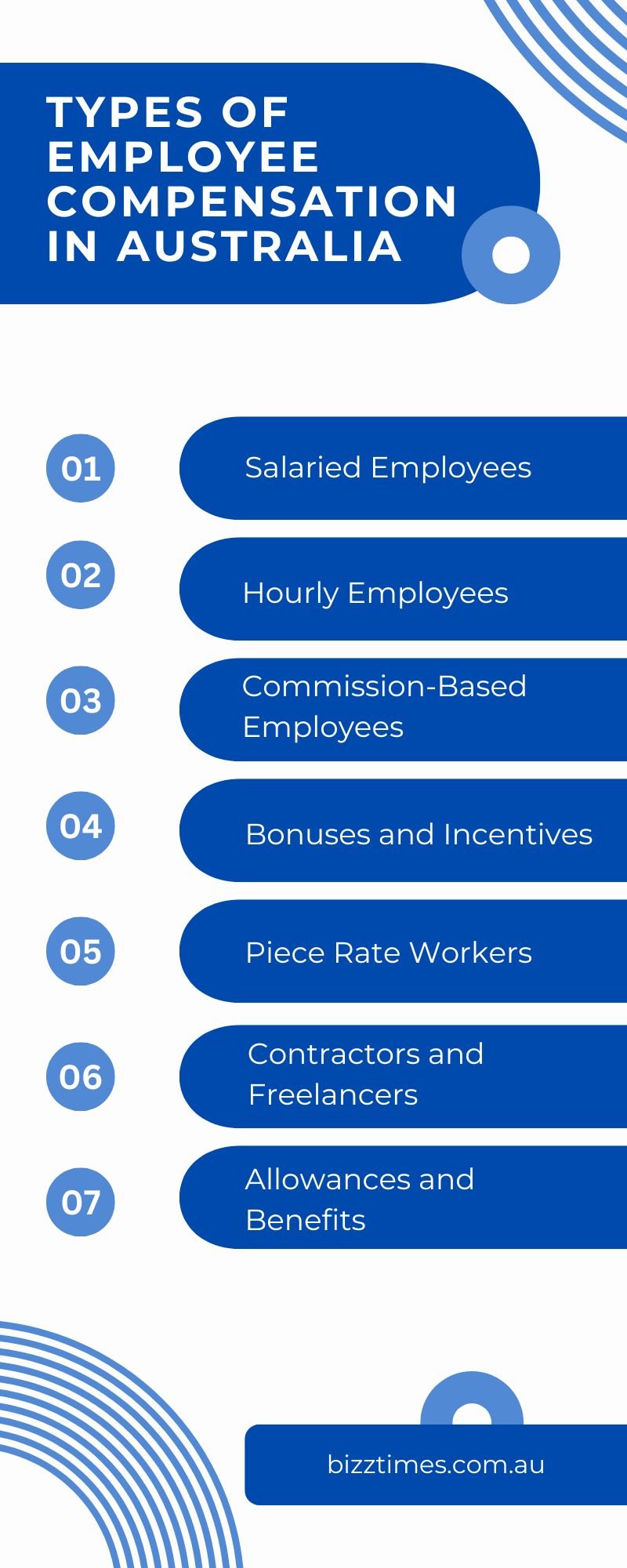Employee Compensation refers to the total remuneration that an employer provides to an employee in exchange for their work. It encompasses not only direct financial payments but also other benefits that contribute to an employee’s overall remuneration package. Here’s a breakdown of its components.
Types of employee compensation in Australia (salaried, Hourly, Commission)

In Australia, employee compensation can come in various forms depending on the type of employment and industry standards. Here are the common types:
1. Salaried Employees
- Definition: Employees receive a fixed annual salary, usually paid on a monthly, fortnightly, or weekly basis.
- Features:
- Stable and predictable income.
- Not typically eligible for overtime unless specified by employment agreements.
- Entitled to paid leave benefits such as annual leave, personal/carer’s leave, and public holidays.
- Example: An administrative manager earning a fixed annual salary of $80,000.
2. Hourly Employees
- Definition: Employees are paid based on the number of hours worked.
- Features:
- Typically eligible for overtime pay at higher rates after a standard number of hours per week/day.
- Entitled to penalty rates for work done on weekends, public holidays, or overnight shifts.
- Entitled to pro-rata paid leave benefits.
- Example: A retail assistant earning $25 per hour with additional rates for weekend shifts.
3. Commission-Based Employees
- Definition: Employees receive compensation primarily based on the achievement of sales or performance targets.
- Features:
- Can be combined with a base salary or offered as a stand-alone payment structure.
- Variable income depending on sales performance.
- Entitled to minimum wage guarantees and paid leave if they are classified as employees.
- Example: A real estate agent earning a base salary of $50,000 plus 10% commission on all sales.
4. Bonuses and Incentives
- Definition: Additional financial rewards provided for achieving specific goals or performance targets.
- Features:
- Typically provided in addition to regular wages or salaries.
- Can be annual performance bonuses, signing bonuses, or incentives for specific project achievements.
- Example: A company provides a 10% annual bonus based on achieving revenue targets.
5. Piece Rate Workers
- Definition: Employees are paid based on the number of units of work they complete rather than hours worked.
- Features:
- Commonly used in agriculture and manufacturing.
- Must earn at least the equivalent of the national minimum wage.
- Example: A fruit picker earning $3 per kilogram of fruit picked.
6. Contractors and Freelancers
- Definition: Individuals who provide services to companies on a contractual basis rather than as employees.
- Features:
- Not entitled to employee benefits like paid leave or superannuation unless specifically included in their contracts.
- Responsible for their own tax obligations and insurance.
- Example: A freelance graphic designer charging $100 per hour for design services.
7. Allowances and Benefits
- Definition: Additional forms of compensation such as travel allowances, housing, and meal benefits.
- Features:
- Can be taxable or non-taxable depending on the type of benefit.
- Included in calculating ordinary time earnings (OTE) for superannuation.
- Example: An employee receives a $20 daily meal allowance for overnight travel.
Calculating overtime pay and bonuses
Calculating overtime pay and bonuses requires a good understanding of relevant legislation, company policies, and employment agreements. Here’s how to accurately calculate these components in Australia:
1. Calculating Overtime Pay
Overtime Pay Rules in Australia
- Governed by the Fair Work Act 2009, Modern Awards, and Enterprise Agreements.
- Ordinary hours are typically 38 hours per week (or the number of hours in a full-time employee’s regular workweek).
- Overtime rates and thresholds depend on the applicable Modern Award or Enterprise Agreement.
General Overtime Rates:
- Time and a Half (1.5x): First 2-3 hours of overtime, depending on the award/agreement.
- Double Time (2x): Any overtime hours beyond the initial threshold.
Example Calculation:
- Scenario: An employee is paid $25 per hour and works 10 hours of overtime in a week. The applicable Modern Award specifies:
- First 3 hours: 1.5x
- Beyond 3 hours: 2x
Steps:
- Calculate Regular Pay:
- Regular work hours: 38 hours x $25/hour = $950
- Calculate Overtime Pay:
- First 3 hours: 3 x $25 x 1.5 = $112.5
- Next 7 hours: 7 x $25 x 2 = $350
- Total Pay:
- Regular pay: $950
- Overtime pays: $112.5 + $350 = $462.5
- Total Gross Pay: $950 + $462.5 = $1,412.5
2. Calculating Bonuses
Bonuses vary significantly and can include annual, performance, or sign-on bonuses.
Types of Bonuses:
- Annual Bonuses: Based on overall company performance or individual contributions.
- Performance Bonuses: Awarded for achieving specific targets.
- Sign-On Bonuses: Incentive to join the company.
Bonus Calculation Considerations:
- Percentage of Salary: Many companies offer bonuses as a percentage of annual salary.
- Fixed Amount: Pre-determined amounts for achieving specific goals.
- Taxation: Bonuses are subject to tax withholding.
Example Calculation (Performance Bonus):
- Scenario: An employee earns an annual salary of $80,000. They receive a 10% performance bonus for exceeding targets.
Steps:
- Calculate Bonus:
- 10% of $80,000 = $8,000
- Apply Tax Withholding:
- Assume a marginal tax rate of 32.5%
- Tax withholding: $8,000 x 32.5% = $2,600
- Net Bonus:
- Net bonus: $8,000 – $2,600 = $5,400
Tips for Accurate Calculations
- Understand Relevant Legislation: Refer to the Fair Work Act, Modern Awards, and Enterprise Agreements.
- Consult Employment Agreements: Review employee contracts for specific terms.
- Use Reliable Payroll Software: Ensure accurate and automated calculations.
- Seek Professional Advice: For complex calculations, consider consulting payroll experts or tax professionals.
By following these guidelines, employers can ensure accurate and fair calculations of overtime pay and bonuses while complying with Australian employment laws.
Tax implications of different types of compensation
Different types of employee compensation in Australia come with varying tax implications. Understanding how each is taxed is crucial for employers and employees to ensure compliance and optimize tax efficiency. Here’s a breakdown of the tax implications of different types of compensation:
1. Salary and Wages
- Tax Implications: Subject to Pay As You Go (PAYG) withholding tax.
- How It’s Taxed:
- Employers withhold income tax based on the employee’s Tax File Number (TFN) declaration and the ATO tax tables.
- Included in the employee’s taxable income and reported through Single Touch Payroll (STP).
2. Overtime Pay
- Tax Implications: Subject to PAYG withholding tax.
- How It’s Taxed:
- Overtime pay is treated as regular earnings and taxed at the same marginal tax rate.
- Reported through STP as part of the employee’s gross income.
3. Bonuses and Commissions
- Tax Implications: Subject to PAYG withholding tax.
- How They’re Taxed:
- Bonuses and commissions are added to the employee’s salary and taxed according to the marginal tax rate.
- Reported through STP.
- Higher bonuses may push employees into a higher tax bracket, increasing their overall tax liability.
4. Allowances
- Travel Allowances:
- Tax Implications: Usually taxable unless exempt (e.g., reasonable travel allowances).
- How They’re Taxed:
- Taxed at marginal tax rates if above ATO-set reasonable limits.
- Reported through STP.
- Meal Allowances:
- Tax Implications: Taxable unless directly related to work activities.
- How They’re Taxed:
- Taxed as part of the employee’s salary.
- Included in gross income for PAYG withholding.
5. Superannuation Contributions
- Employer Contributions:
- Tax Implications: Not taxable income for the employee directly but included in the employee’s superannuation fund.
- How It’s Taxed:
- Employer contributions are taxed at 15% within the superannuation fund.
- Reported through STP and relevant superannuation forms.
- Salary Sacrifice Contributions:
- Tax Implications: Treated as employer contributions.
- How They’re Taxed:
- Taxed at 15% within the superannuation fund.
- Reduce the employee’s taxable income.
6. Fringe Benefits
- Tax Implications: Subject to Fringe Benefits Tax (FBT).
- How They’re Taxed:
- Employers pay FBT on the taxable value of fringe benefits provided to employees.
- Common examples include company cars, low-interest loans, and entertainment.
- Some benefits may have exemptions or concessions.
7. Employee Share Schemes (ESS)
- Tax Implications: Subject to special rules under the Employee Share Scheme legislation.
- How They’re Taxed:
- Taxable when shares/options are provided (or at a later point if deferred).
- Employees may receive discounts or exemptions depending on the scheme structure.
8. Termination Payments
- Redundancy Payments:
- Tax Implications: Partly exempt up to a certain limit.
- How They’re Taxed:
- Tax-free up to a limit based on the employee’s service length.
- The excess is taxed at special rates.
- Unused Leave Payments:
- Tax Implications: Taxable as part of employment termination payments (ETPs).
- How They’re Taxed:
- Annual leave is taxed at a flat rate of 32%.
- Long service leave is taxed at 32% (pre-16 August 1978 service) or 15% (post-16 August 1978 service).
Common Employee Benefits (Health Insurance, Retirement Plans, etc.) in Australia
In Australia, employee benefits are crucial for attracting and retaining top talent. Here are some of the most common benefits provided to employees:
1. Superannuation (Retirement Plans)
- Definition: Mandatory employer contributions to an employee’s retirement fund.
- Details:
- Employers are required to contribute at least 10.5% (as of 2021-2022) of the employee’s ordinary time earnings (OTE) to a superannuation fund.
- Employees can make voluntary contributions to increase their retirement savings.
- Tax Implications:
- Employer contributions are taxed at 15% within the fund.
- Additional tax concessions may apply to voluntary contributions.
2. Health Insurance
- Definition: Employer-provided private health insurance for employees and sometimes their families.
- Details:
- Includes coverage for hospital, medical, dental, and optical services.
- Employers can negotiate group policies for more affordable rates.
- Tax Implications:
- Can be subject to Fringe Benefits Tax (FBT).
- Employees may be eligible for a private health insurance rebate.
3. Salary Packaging and Fringe Benefits
- Definition: Salary packaging allows employees to receive part of their income as benefits, potentially reducing their taxable income.
- Common Benefits:
- Novated Leases: Vehicle lease payments are deducted from pre-tax income.
- Portable Electronic Devices: Laptops, mobile phones, etc., are often tax-free.
- Meals and Entertainment: Subsidized meals, holiday accommodation, and entertainment.
4. Paid Leave Benefits
- Annual Leave:
- Full-time employees are entitled to 4 weeks of annual leave per year.
- Shift workers may receive 5 weeks of leave.
- Personal/Carer’s Leave:
- 10 days of paid leave per year for illness, caring for family members, etc.
- Parental Leave:
- Up to 18 weeks of paid parental leave for primary caregivers.
- Dad and Partner Pay provides 2 weeks of paid leave.
- Long Service Leave:
- Employees receive a minimum of 8.67 weeks of leave after 10 years of service.
5. Employee Assistance Programs (EAP)
- Definition: Confidential counseling services for employees to help manage personal or work-related issues.
- Details:
- Services often include mental health support, financial advice, and legal counseling.
- Usually provided through third-party organizations.
6. Professional Development and Training
- Definition: Programs designed to help employees improve skills and career prospects.
- Examples:
- Tuition reimbursement for work-related courses.
- Access to online learning platforms and workshops.
7. Flexible Work Arrangements
- Definition: Allowing employees to work in a way that suits their lifestyle or needs.
- Examples:
- Flexible Hours: Variable start and finish times.
- Remote Work: Working from home or other locations.
- Job Sharing: Two people sharing one full-time role.
8. Wellness Programs
- Definition: Initiatives aimed at improving employee health and well-being.
- Examples:
- On-site gyms or gym membership reimbursements.
- Yoga, meditation classes, or mental health workshops.
- Smoking cessation programs.
9. Transportation Benefits
- Definition: Subsidized or employer-provided transportation.
- Examples:
- Public transport passes or reimbursements.
- Employer-provided shuttle services.
- Parking benefits.
Navigating employee benefit deductions in payroll
Navigating employee benefit deductions in payroll requires a comprehensive understanding of the benefits offered to employees and how they impact their compensation. This involves accurately calculating deductions for items such as health insurance premiums, retirement contributions, and other voluntary benefits. It also entails staying updated on changes in benefit plans, ensuring compliance with relevant laws and regulations, and effectively communicating deductions to employees on their pay stubs. Efficiently managing benefit deductions helps ensure employees receive the full value of their benefits while maintaining payroll accuracy and compliance.
The Australian Government provides detailed information on payroll governance and the obligations of employers through the Australian Taxation Office (ATO). They outline the need for a formal payroll framework, accurate reporting of Single Touch Payroll (STP), Pay As You Go (PAYG) withholding, fringe benefits tax (FBT), superannuation, and good record-keeping practices. For comprehensive guidance on meeting your payroll obligations and understanding common issues with payroll governance, you can refer to the ATO’s official page on Improving Payroll Governance.
Additionally, for a broader understanding of payroll tax obligations and compliance in Australia, you might find the Australian business payroll tax obligations compliance guide helpful. It provides insights into efficient payroll management and the importance of maintaining accurate payroll records for legal compliance and financial management.
FAQs:
Employee benefits in Australia may include superannuation contributions, paid leave (such as annual leave, sick leave, and long service leave), health insurance, and other perks like employee assistance programs.
Compensation and benefits play a crucial role in employee motivation by providing financial security, recognizing employee contributions, and offering incentives for performance and loyalty.
Employee compensation can be calculated by adding base salary or hourly wages to any additional earnings or bonuses, then deducting taxes and other withholdings to determine the net pay.
Payroll refers to the process of calculating and distributing employee wages, while payout typically refers to the actual disbursement of funds to employees.
In Australia, employers are generally required to pay employees their wages within seven days after the end of the pay period, according to Fair Work regulations.












